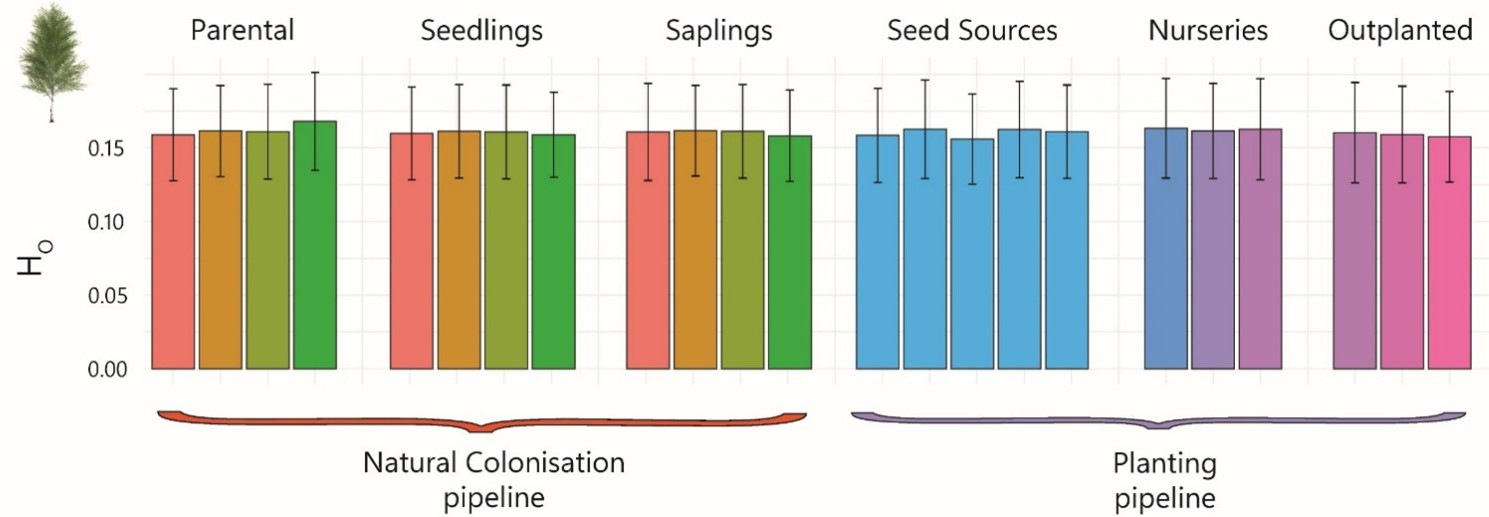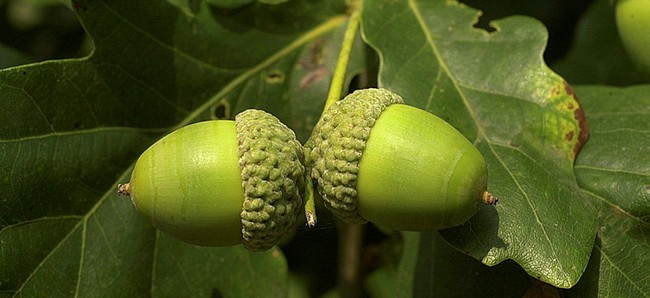Policy and Practice Briefing:
Genetic Consequences of Tree Planting Versus Natural Colonisation
Project leads Dr. James Borrell I Royal Botanic Gardens, Kew; Dr. Nadia Barsoum I Forest Research
Headlines
- A combination of both planted and naturally colonised new woodlands is likely to be best for maintaining genetic diversity.
- Current registered seed stands do not represent the full range of climate diversity in wild populations.
- Natural and planted populations have different risks of inbreeding that could potentially reduce future genetic diversity.
- Planted populations from different areas are similar to each other, which could reduce genetic diversity at landscape scale.
- Differences in health indicators between planted and natural populations suggest that planting protocols can affect selective pressures.
Background
The UK has set ambitious goals to establish nearly a million hectares of new woodland by 2050, employing both active tree planting and passive natural colonisation strategies. Maintaining genetic diversity is essential to ensuring that newly established woodlands are resilient to emerging environmental pressures such as climate change or pests and diseases.
This policy brief reports the genetic outcomes of these two afforestation strategies for two widespread UK broadleaf species: pedunculate oak (Quercus robur) and silver birch (Betula pendula).
Key findings
- Registered commercial seed stands significantly underrepresent the full bioclimatic diversity found in wild tree populations, potentially limiting the adaptive capacity of planted populations.
- Planted populations have genetic diversity levels comparable to naturally colonised populations, indicating current planting practices largely avoid severe genetic bottlenecks.
- Individuals within planted populations exhibited higher levels of relatedness, increasing the risk of inbreeding and potential loss of genetic diversity in future generations.
- Planted populations displayed higher genetic similarity across sites at regional and supra-regional scales, potentially reducing adaptive differentiation across the landscape.
- Naturally colonised populations showed higher inbreeding, possibly due to fragmented parental populations in degraded landscapes, which may compromise long-term resilience.
- Subtle signals of differential selection and notable differences in health indicators were observed when comparing planted and naturally colonised populations, suggesting that planting protocols may introduce selective pressures that ideally, should be avoided.
Considerations for policy and practice
Opportunities to improve management of genetic resources
Expand and diversify seed sourcing
The climatic breadth of current commercial seed stands inadequately represent the full bioclimatic diversity of wild populations. Investment in broader networks of registered seed stands and seed orchards would be beneficial for maintaining adaptive diversity.
Address fragmentation effects
Natural colonisation sites often experience elevated inbreeding. This is likely due to isolation and limited gene flow, resulting in a scarcity of parental trees contributing to the genetic pool of newly established populations. Policymakers should consider assisted gene flow, hybrid approaches combining planting with natural colonisation, and improvements in landscape connectivity to mitigate these effects.
Avoid planting populations of closely related individuals
Higher within-site relatedness in planted populations highlights the need to increase the number of regional seed sources and parental trees within commercial seed stands. This would reduce risks of future inbreeding and loss of genetic diversity. Within nurseries, there may also be opportunities to supply batches of saplings that explicitly mix offspring of different sources within a region.
Avoid genetic homogenisation
Higher between-site relatedness among planted populations at regional and supra-regional levels highlights the importance of using seeds from diverse local sources, potentially including the use of local orchards, to preserve genetic diversity across larger geographic scales and reduce risks of genetic homogenisation.
Monitor for unintended selection
Subtle genetic signals suggest that current nursery and planting practices may inadvertently select for specific traits. Monitoring and review of nursery practices may be advisable to maintain resilience and adaptability.
Enhanced knowledge exchange and training
Collaboration between researchers, land managers, nurseries, and seed suppliers is essential to share best practices, address genetic risks and assist researchers in understanding the impacts of industry practice on research findings.
The research
Using large, high-quality genomic datasets, we used different metrics to determine if planting introduces genetic bottlenecks or reduces diversity compared to natural colonisation. Comparisons between afforestation strategies were conducted by grouping trees into comparable age cohorts: parental trees, seedlings, and saplings in the case of natural colonisation; seed sources, nursery trees, and outplanted trees in the case of planting. Our results showed reassuringly similar genetic diversity both between age cohorts and across afforestation strategies (Fig. 1).

Figure 1: Levels of genetic diversity measured as observed heterozygosity (HO) in silver birch. Each bar represents a tree group from either natural colonisation or planting pipelines. Differences across groups are limited, indicating broadly similar genetic diversity across afforestation strategies.
Genomic tools also enabled us to identify levels of within- and between-group coancestry, inbreeding, and selection potentially caused by planting methods. Planted populations had significantly higher within-group coancestry, meaning trees at each site were more closely related to one another than in natural populations, which may result in a loss of genetic diversity in subsequent generations. Between-group coancestry was also higher in several planted populations, revealing moderate genetic homogenisation, potentially reducing landscape complexity andadaptive differentiation among woodlands.
In contrast, naturally colonised populations exhibited higher levels of recent inbreeding, probably due to fragmented landscapes. Genomic analyses also detected subtle signs of differential selection between planted and naturally colonised populations. For example, genes associated with flowering time, fruit detachment, and stress resistance showed evidence of selection, indicating unintended selective pressures in commercial tree production. Health indicators, including deer browsing damage and disease incidence, were assessed at multiple sites to detect differences linked to planting versus natural establishment.
Our assessments confirmed significant differences between afforestation strategies, with planted trees generally experiencing reduced browsing damage but differing levels of disease susceptibility.
Further information
Friis et al. Genetic Consequences of Tree Planting Versus Natural Colonisation: Implications for Afforestation Programmes in the United Kingdom. Evolutionary Applications. August 27, 2025. DOI: https://doi.org/10.1111/eva.70146
You can find out more about the project here: Evaluating genetic and environmental bottlenecks in planted and naturally colonised woodlands.
Published: 28 August 2025.
Glossary & Key Terms
Adaptive differentiation/divergence
Genetic divergence among populations driven by selection in different environments, leading to locally adapted traits.
Assisted gene flow
Bioclimatic diversity
Coancestry
Commercial seed stands
Differential selection
Gene flow
Genetic bottleneck
Genetic diversity
Genetic homogenisation
Genomic tools
Share this project on social media
Our Partners
Social media
Explore
Newsletter
Contact
© 2022 Centre for Forest Protection. All rights reserved.
